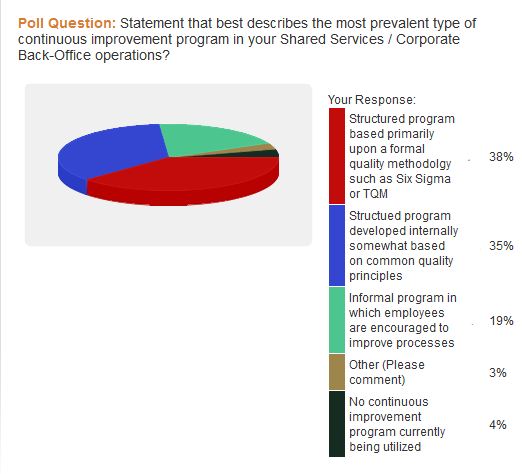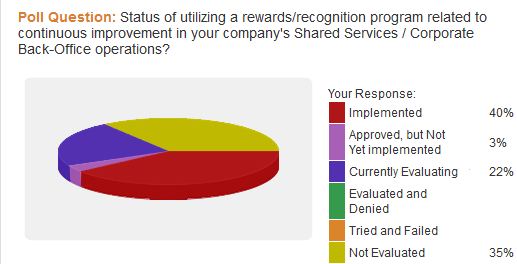Continuous Improvement – Is it in Your Shared Services DNA?
While many companies have realized significant savings when first transitioning to Shared Services, uncovering additional saving opportunities can be a challenge without proper focus. One attribute of many successful Shared Services operations is a well-established continuous improvement program that is ingrained within the culture of the operation.
Recently a poll, followed by a webcast featuring a member company within the Shared Services Leadership research area (one of ten research areas within Peeriosity), honed in on what Shared Services leaders were doing within their organizations to ensure that a continuous improvement culture was embedded into the Shared Services “DNA”.
Having a formalized structured program was identified as a best practice, with 38% of companies using a formal methodology (e.g. Six Sigma) and another 35% using internally developed quality programs based on formal quality methodologies. In total, 73% of Shared Services respondents had formalized programs, with another 19% having programs that encourage continuous improvement.
The follow-up question asked if a reward/recognition program was related to the continuous improvement program. The response was not as overwhelming as the prior question on having a program, with 40% having implemented some form of reward/recognition linked directly to the continuous program.
The discussion continued as Shared Services leaders participated in a lively webcast on this topic. All agreed that continuous improvement is expected of Shared Services organizations. Year-on-year productivity improvements are a given, but quality and customer service also weigh heavily into the equation and are not as easy to quantify.
Our feature company discussed their journey in not only implementing a formalized program but the steps they took to enable the appropriate cultural mindset. They initially chose to NOT have a formalized program and instead commenced with a small team dedicated to ongoing improvement and transformation efforts. With the idea in mind to eventually move to a more formalized approach, this skill set of team members included project management skills, finance and accounting acumen, comfort with new technology as an enabler, and experience in quality management (preferably Six Sigma certified).
Once the team had some initial success, the next evolution was to embed the team within process areas (as part of Shared Services). Each member would focus on a particular end-to-end process and become a member of that particular process team. Once on the team, they would introduce quality management principles as part of the normal operations and reporting of the team.
Over time, all members of the Shared Services organization were being exposed to quality techniques and continuous improvement was part of everything they were doing. A natural next step was to set a goal to become Six Sigma certified, with team goals for a specific number of levels of certification of team members. These certification levels included at least one member per team becoming a black belt and all manager and director levels achieving at least a green belt.
The results have been outstanding. The culture and spirit to improve are in everything they do and the broader organization calls upon Shared Services on a regular basis for projects that just a few years ago would have been completely out of their scope. Shared Services has now become a strategic enabler of the broader organization’s transformation strategy.
Is your Shared Services organization viewed as a springboard and enabler for greater transformation efforts?
Peeriosity helps you find your way forward by leveraging the knowledge and experience of your peers, quickly.
Who are your peers and how are you collaborating with them?



